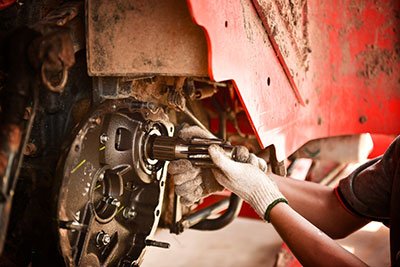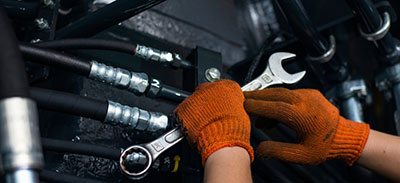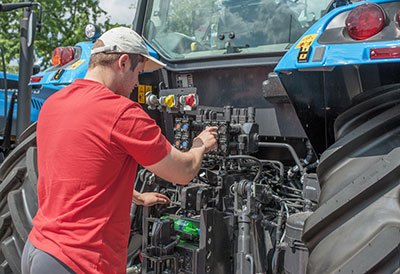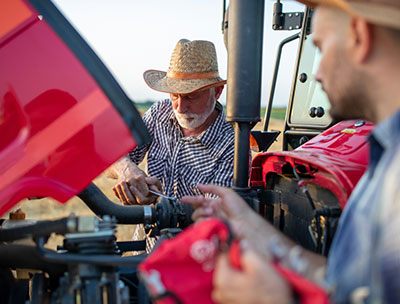Are you an agricultural worker who spends most of your time on a tractor? If so, it’s vital to make sure your machinery is in top shape for optimal performance.
In this post, we’ll provide expert tips about the latest maintenance strategies for tractors. We’ll go into detail on how to ensure your tractor remains safe and reliable across demanding working conditions.
We will also give you advice on inspecting the machine’s components and making necessary adjustments before they cause issues down the line. Read on to get all the info you need to keep up critical mechanical efficiency!
Take away key points:
- Tractor maintenance requires inspection and removal of problematic fuel and oil filters, a battery, electrical parts, spark plugs, and all other units causing issues
- Always consult your manual to ensure the best maintenance tips and tricks
- Ensure the parts are all working properly to avoid potential high risks of severe injuries and fatal consequences
Table of Contents
- A must-read tractor maintenance checklist!
- What is tractor maintenance?
- What’s the main purpose of tractor maintenance?
- What to check every time you use your tractor?
- 1. Air filter
- 2. Fuel filter
- 3. Hydraulic systems (hydraulic fluid)
- 4. Combined systems
- 5. Hydraulic oil
- 6. Engine oil
- 7. Engine coolant
- 8. Hydrometers
- 9. Safety belts
- 10. Checking hand brake
- 11. Checking foot brake
- 12. Checking differential lock and four-wheel drive
- 13. Tractor hoses
- 14. Hydraulic lines replacement
- 15. Grease
- 16. Don’t forget your tractor maintenance schedule
- 17. Additional touch-ups
- Daily tractor maintenance checklist
- Tractor operation safety tips
- Other valuable tractor maintenance tips
- FAQs
- How often does a tractor need to be serviced?
- Are tractors expensive to maintain?
- What is the daily maintenance of a tractor?
- What is the periodic maintenance of a tractor?
- Can I leave my tractor outside?
- How much does it cost to repair a tractor tire?
- How do you repair a tubeless tractor tire?
- How do you repair a tractor tire tube?
- How to repair a fiberglass tractor canopy?
- How to repair hydraulic lift on 8N Ford tractor?
- How to Repair MTD lawn tractor transmission problems?
- Summary
A must-read tractor maintenance checklist!
To ensure the optimal performance of your tractor, you must maintain it properly.
If you wonder about the best steps and full maintenance procedure, refer to the guide below. You will find the best solution to your issues.
What is tractor maintenance?

Tractor maintenance is the practice of regularly inspecting and servicing a tractor to keep it running efficiently and safely. Regular maintenance is essential for keeping a tractor in good working condition and avoiding costly repairs or breakdowns.
Tractor maintenance should include checking belts and hoses, hydraulic lines, air filters, tires, fuel systems, and engine oil. It’s also important to inspect the radiator and all its screens, as well as the battery terminals.
Additionally, farmers should consider taking their tractors to a dealer for periodic maintenance checks. Following these tips can help ensure that your tractor remains in tip-top shape!
What’s the main purpose of tractor maintenance?
Tractor maintenance is an important part of owning and operating a tractor. Regular maintenance helps to ensure that the tractor runs efficiently, safely, and reliably.
By performing regular maintenance checks, you can identify any potential problems before they become serious issues. This can save time and money in the long run by avoiding costly repairs or replacements.
Regular maintenance also helps to extend the life of your tractor by keeping it running at its peak performance level.
Properly maintained tractors are more reliable and last longer than those that are not properly maintained. Additionally, regular maintenance can help to reduce fuel consumption and emissions, which is beneficial for both the environment and your wallet.
Finally, regular maintenance helps to keep you safe while operating your tractor. By regularly inspecting all parts of the tractor, you can identify any potential safety hazards before they become a problem. This includes checking for worn or damaged parts that could cause an accident or malfunction while using the tractor.
Overall, regular tractor maintenance is essential for ensuring that your tractor runs safely, efficiently, and reliably for years to come.
What to check every time you use your tractor?
Here is the tractor maintenance checklist to ensure the tractor standards. Follow the standards to ensure all tractor parts operate correctly for the best use of your machinery.
Of course, you can also check your tractor’s manual for proper maintenance, but we have gathered all tractor maintenance tips here.
The critical tractor maintenance checklist points include:
1. Air filter
Periodically inspect your air filter or the air filter restriction gauge to ensure that it is working in top condition. Clogging can occur quickly as tractor works involve tasks such as mowing, tilling, grading driveways, and moving materials like dirt, debris, sand, gravel, and manure which may kick up a lot of dust.
Check if you can see daylight through your filter medium or if it has been loaded with dirt so much that the light can’t pass through. Look out for signs such as increased smoking, power loss, or tractor engine starving out as they are all cues to change the air filter.
2. Fuel filter
It is essential to fuel filters for tractors to stop contaminants from entering the engine and causing irreparable damage. These fuel filters need regular maintenance and if neglected, could easily leave you without a tractor.
Some diesel applications even include a water separator in their fuel filter to reduce the risk of harm caused by water mixing with diesel fuel. Make sure you are familiar with how your specific fuel filter works, to ensure its proper maintenance.
3. Hydraulic systems (hydraulic fluid)
Built-in hydraulic systems in modern agricultural tractors are responsible for powering implements and bucket loaders, and feature a filter to capture contaminants from the circulating oil filters. So, your hydraulic system will keep the overall fluid level optimal and keep the machine free of rust.
Change the filter of the hydraulic system as recommended by your owner’s manual to avoid any air pressure-related issues with your system. A clogged fuel filter will cause your bucket loader or hydraulic implements to slow down or even lose power altogether. So, you must keep the oil filter flawless for maximum mechanical power and fuel stabilizer.
4. Combined systems
It is important to take note that many current tractors share hydraulic fluid between the transmission and implements. The hydraulic lines and transmission oil filters can be the same.
On the other hand, older tractors usually feature a dedicated system that requires independent inspection.
5. Hydraulic oil
It is commonplace for most modern tractors to feature either a sight glass window or dipstick near the PTO shaft, with which you should frequently check the hydraulic oil level.
Remember that improper fluid levels in the system can lead to damage and performance issues for your tractor engine and equipment. Therefore, it is best to take your readings from the tractor with no implements attached and with any bucket loaders lowered.
6. Engine oil
Much like a car or truck, your tractor will require an oil filter change eventually. Unlike cars and trucks, which are serviced based on mileage, tractors can be serviced based on their operating hours.
This means checking the hour or “Hobbs” meter found on your unit’s dash. Doing so ensures that you will also be changing the oil filter at the same time. So, always pay attention to your diesel fuel filters, and use the new oil filter if necessary to ensure the best maintenance tips for the grease used.
7. Engine coolant
Contaminants and deposits can accumulate in the engine coolant system due to wear and tear, which can lead to internal damage including rusting and clogging.
To avoid such issues, a periodic flush and replacement of radiator fluid, grease, and fuel filter are recommended. When changing the coolant, it is also advised to replace the thermostat for additional safety.

8. Hydrometers
As winter approaches, it is important to check the freezing point of your coolant with a coolant hydrometer. If it fails the test, you will need to replace it and ensure proper maintenance in cold weather. The same goes for the gas tank – drain plug and filter before the wintertime.
Furthermore, when flushing the system, be sure to conduct a pressure gauge check for any potential leaks. Additionally, make sure that the hydrometer being used is compatible with your type of coolant as this will ensure an accurate reading and prevent compressed air.
9. Safety belts
The engine belts on the front of your tractor are essential for spinning its various components. Alternator, coolant pump, and hydraulic pumps all use these belts to transmit power from the crankshaft and prevent debris and rust.
For them to do the proper belt jobs, these V and Serpentine belts should be flexible and able to bend without cracking or splitting. When inspecting them, look out for signs of cracking, glazing of the friction surface, and other forms of wear or damage.
If a belt must be removed, flip it over and flex it to check if it snaps or cracks. This is an indicator that you need to replace it. Non-friction surfaces can have the date of installation or hour meter reading written on them as reference points.
10. Checking hand brake
Before you move the tractor, make sure to check that the hand brake is disengaged. If you experience any difficulty when operating the tractor, double-check that it is off.
When traveling with the tractor at a slow speed on a gentle incline, place it in neutral and engage the hand brake to make sure it is functioning correctly.
11. Checking foot brake
A tractor needs to be able to stop, or else the consequences could be dire. For tractors that have individual brakes on either side, it is important to test each one individually and adjust them so they have an equal braking effect.
Consider adding a metal bar to lock the two together, as this will help ensure that both brakes operate with the same force. A tractor with only one working brake is more prone to rollover in hilly areas or during turns at higher speeds.
If you feel a mushy sensation when engaging the hydraulic brakes, there may be air trapped in the air filters and lines. Follow the owner’s manual and manufacturer’s instructions to bleed out any air and repair accordingly.
12. Checking differential lock and four-wheel drive
It’s important to be mindful when dealing with muddy barnyards and other hard surfaces. Using either one of the particular controls on the machine for such terrain will cause unnecessary wear and tear on the drive train.
13. Tractor hoses
Rubber doesn’t last forever. Monitor your coolant hoses and hydraulic lines regularly for any signs of deterioration, as they can split or crack and cause leaks in your machine. Take a closer look at the flex points, like around the loader hinges, since these are where they are most likely to give out.
14. Hydraulic lines replacement
When it comes to hydraulic line replacement, many commercial shops, most auto parts stores, and tool stores can make them while you wait. Have the original hose handy to obtain an accurate duplication. Keep the old line even if broken, as a reference in case the new one doesn’t fit properly.
15. Grease
Your tractor has numerous moving parts, and it’s important to keep them well-lubricated. Regular greasing of your tractor will help you prevent corrosion, and adding the right type of grease/oil helps in keeping the machinery optimal.
Look out for grease zerk fittings on your joints and pivot points – if there is one, then the joint should be greased. Investing in a battery-powered grease gun can make regular greasing much easier, as manually pumping the grease gun can be tiresome.
16. Don’t forget your tractor maintenance schedule
Remembering the date of your last tractor maintenance check can be difficult to keep track of. Creating a maintenance logbook is an excellent way to document your repairs and actions.
Additionally, writing the hour meter reading on any new filter, hose, or part you install with a paint marker (not sharpie) when it is fitted may be helpful in future troubleshooting.
17. Additional touch-ups
During your tractor maintenance routine, it is not uncommon to come across metal patches that have lost their paint. Though it is almost impossible to protect the bucket from this issue, regularly touching up the rest of your tractor’s paint can help prevent rusting and preserve its appearance.
So, the process will save money as you won’t have to replace the damaged parts. Many hardware and farm supply stores sell tractor paints in spray cans, so a quick top-up here and there can go a long way.
Daily tractor maintenance checklist

Before you embark on any task with a tractor, it’s wise to take a few minutes to check the following:
- fuel gauge level,
- oil dipstick range and top off if below 0.5 quarts,
- coolant levels and top off if necessary,
- clearing of radiator debris for flow optimization,
- tire pressure check (especially for front tires to ensure load-bearing capabilities),
- roll bar safety check,
- lights inspection if anticipated usage,
- pins and connectors security assessment,
- hydraulic lines condition observation,
- oil/fuel leakage lookout,
- communication devices – battery and signal strength confirmation.
Taking the initiative to do this daily can save you much stress and expenditure in the long run.
Tractor operation safety tips
When operating a tractor, it is important to take the necessary safety precautions. Here are some tips to help keep you safe:
– Read and follow directions in the equipment owner’s manual. Pay attention to safety instructions in the manual and any warning labels on the tractor.
– Wear fitted pants, tuck in loose shirt tails, and avoid wearing scarves or other loose clothing that could get caught in moving parts of the tractor. Protect your feet by wearing sturdy work shoes or boots with non-skid soles.
– Wear nitrile gloves as they are more chemically resistant when maintaining your tractor. Also, wear safety glasses even if you normally wear prescription glasses.
– Firmly attach the seat belt when operating the tractor, as well as any other appropriate safety devices such as rollover protective structures (ROPS).
– Always start and stop the tractor slowly, and drive slowly while being aware of your surroundings at all times.
– Test the brakes each time you use the tractor to make sure they are working properly before starting on a job or task.
– Never start an engine indoors; exhaust contains carbon monoxide which is colorless, odorless, and deadly.
– Always keep the PTO shaft shielded when using a mower attachment or any other type of implement attached to your tractor. This will help prevent injuries from flying debris or objects that may be thrown off by rotating blades or other machinery components spinning at high speeds.
– Keep children away from tractors at all times. Never allow them to ride on them or operate them without proper supervision from an adult who knows how to safely operate a tractor and its attachments/implements correctly and safely for their age group/level of experience/maturity level etc.
– Make sure all controls are in neutral before starting up your engine; this will help prevent accidental movement of levers that control speed, direction, etc.
– Be aware of potential hazards such as overhead power lines when operating a tractor near them; always stay clear of these areas if possible and never operate a machine under them unless necessary for completing a task safely and efficiently with proper training/supervision etc.
Other valuable tractor maintenance tips
Keeping your tractor in good condition is essential for any farmer.
To help you out, here are some valuable tractor maintenance tips to keep your tractor running smoothly and efficiently all year round.
Check the oil level regularly – Checking the oil level of your tractor is an important part of regular maintenance. Make sure to check it at least once a month and top up if necessary.
Clean the air filter – The air filter is responsible for keeping dirt and debris from entering the engine, so it’s important to clean it regularly. This should be done every 50 hours or so, depending on how often you use your tractor.
Inspect and clean the battery – Batteries can corrode over time, so make sure to inspect them regularly and clean them with a wire brush if necessary. The water level of the tractor battery must be examined weekly. If you find the water level below the required, you must fill it with distilled water.
Assess tire condition – Tires can wear down quickly if they’re not properly maintained, so check them regularly for signs of wear and tear. If they need replacing, replace them as soon as possible to avoid any potential problems down the line.
Check electrical issues – ensure there aren’t any problems with the electric system of your tractor. If you still notice something wrong, you must act immediately and replace the damaged parts with the best tractor maintenance tips.
Sharpen blade attachments – Blades can become dull over time, so make sure to sharpen them regularly to ensure they stay sharp and effective when cutting through tough material like grass or weeds.
Check belts for wear and tear – Belts are an important part of any tractor’s operation. Make sure to inspect them regularly for signs of wear and tear that could lead to problems down the line if left unchecked.
Fill the tank with new fuel – Old fuel can cause problems with your engine’s performance. So, make sure to fill up with fresh fuel and new oil whenever possible to keep things running smoothly and efficiently all year round.
FAQs
How often does a tractor need to be serviced?
It’s recommended that you service your tractor at least once a year or every 200 hours of use, whichever comes first. Regular servicing helps to keep the engine running smoothly and efficiently, as well as reduce the risk of breakdowns or other issues.
Are tractors expensive to maintain?

Generally, regular maintenance such as checking belts and hoses, replacing air filters, and changing engine oil can be done relatively inexpensively. However, more extensive repairs or replacements of parts can become costly. Purchasing spare parts for preventative maintenance can help you save money in the long run.
What is the daily maintenance of a tractor?
The daily tractor maintenance tips include:
– checking gauges
– checking the hand and foot brakes
– examining the tractor toolbox
– checking the four-wheel drive and differential lock.
What is the periodic maintenance of a tractor?
Periodic tractor maintenance checklist includes:
– checking battery terminal puller
– cleaning battery terminals
– cleaning caps
– cleaning and changing fuel filters
– changing the oil at recommended intervals.
Can I leave my tractor outside?
Yes, you can leave your tractor outside, but there are a few important tips to follow if you do.
It is best to store your tractor in a barn or shed if possible, as this will keep it dry and protected from the elements. If that isn’t an option, you should at least cover it with a tarp or car cover during the winter months.
Additionally, putting a garbage bag over the seat will protect it from sun and rain damage.
How much does it cost to repair a tractor tire?
It would cost $20-$40 for an implemented tire fix. But for larger non-fluidized tires, it would cost $300-$400 if professional repairs it.
How do you repair a tubeless tractor tire?
Follow the steps below:
– Locate the puncture or slice in the tire.
– Deflate the tire and glue the puncture or slice it back together.
– Apply a patch over the damaged portion of the tire using an adhesive that is specifically designed for repairing tires.
– Fill the tire with air and check for any leaks.
How do you repair a tractor tire tube?
Follow the steps below:
– Remove the wheel from the tractor.
– Unhook the tire from the wheel with tire levers.
– Inspect the tire and tube for any punctures or holes.
– Prepare the tube for patching by cleaning it with rubbing alcohol and allowing it to dry.
– Apply some glue around the hole.
– Place your patch over it and press firmly.
– Allow it to dry for at least 15 minutes before reinstalling your wheel onto the tractor.
How to repair a fiberglass tractor canopy?
Follow the procedure below:
– Cut out the damaged fiberglass and taper the edge.
– Use an epoxy resin to fill in the gap.
– You may also need to lay in some fiberglass matting for extra reinforcement. Make sure you have the right mounting kit for your tractor canopy, to ensure that it is securely attached to your tractor.
How to repair hydraulic lift on 8N Ford tractor?
Follow the procedure below:
– remove and rebuild the hydraulic pump.
– loosen the differential case with a 9/16” open-end wrench and the Ford Plow Wrench or a 1-1/16” wrench.
– inspect it for any leaks or damage, and replace any necessary parts.
– check for any other sources of leaks that may be present in the system. This includes checking for leaky axle seals, brakes, and lower lift pins.
– remove the pump and replace it with a new one.
– replace some of the components in your hydraulic lift system such as rod connections or control valve spools.
– consider replacing your hydraulic lift cover repair kit which includes 2 1/2″ O rings.
How to Repair MTD lawn tractor transmission problems?
Follow the steps below:
– Check the transmission fluid level and make sure it is full. If it is low, fill it up and see if that solves the issue. If not, inspect the drive belt for signs of wear or damage. If the belt looks worn or frayed, replace it with a new one.
– Check the transaxle for any loose parts or broken components. If something appears to be out of place or damaged, replace it with an OEM part from your local MTD dealer. If all else fails, consider rebuilding or replacing your transaxle altogether.
Summary
Taking care of your tractor is essential to make sure that you can stay safe when you operate it, as well as maintain the longevity of the machine.
Additionally, it’s important to check for any defects and not ignore any symptoms of wear and tear.
